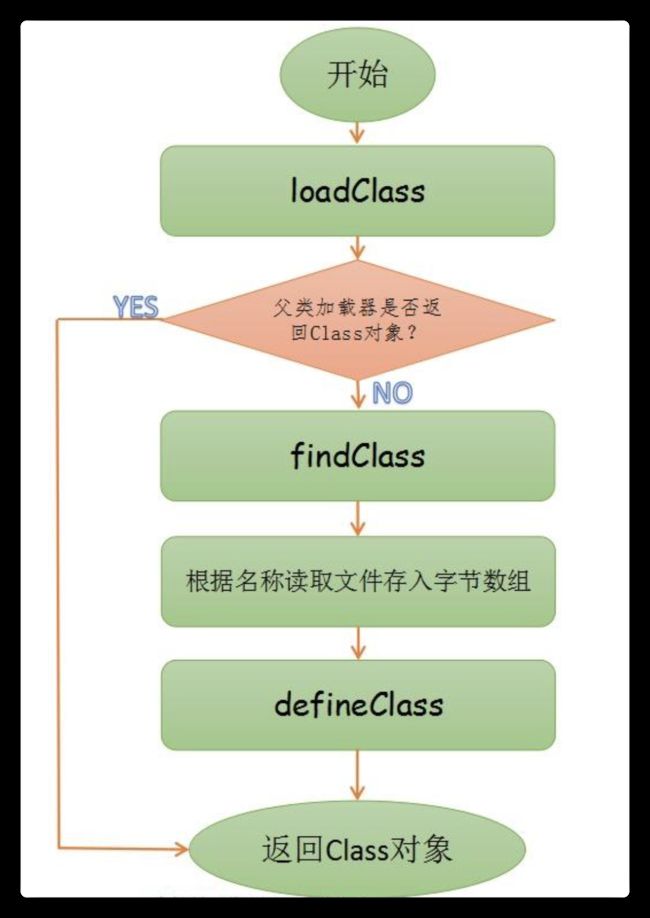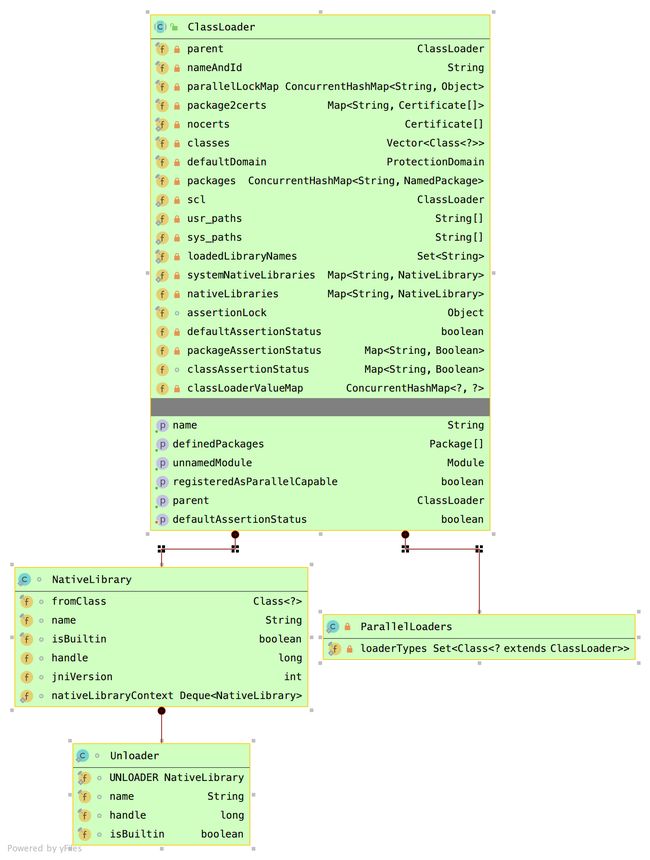摘要
本文主要介绍 Java 类加载器的原理和应用场景。
What is ClassLoader?
ClassLoader的具体作用就是将class文件加载到jvm虚拟机中去。
为什么需要类加载器?
jvm启动的时候,并不会一次性加载所有的class文件,而是根据需要去动态加载。
你想啊,假如一次性全部加载项目中的所有的 jar 包,那么多class,那内存还不崩溃?
其实,我们在搭建JDK开发环境的时候,就配置了CLASSPATH环境变量,就是为了 JVM 启动需要的加载的JDK开发jar包组:
CLASSPATH=.;%JAVA_HOME%\lib;%JAVA_HOME%\lib\tools.jarJAVA类加载流程
三个类加载器
Java语言系统自带有三个类加载器:
Bootstrap ClassLoader
最顶层的加载类,主要加载核心类库,%JRE_HOME%\lib下的rt.jar、resources.jar、charsets.jar和class等。
Bootstrap ClassLoader是由C/C++编写的,它本身是虚拟机的一部分,所以它并不是一个JAVA类,也就是无法在java代码中获取它的引用,JVM启动时通过Bootstrap类加载器加载rt.jar等核心jar包中的class文件,之前的int.class,String.class都是由它加载。然后呢,我们前面已经分析了,JVM初始化sun.misc.Launcher并创建Extension ClassLoader和AppClassLoader实例。并将ExtClassLoader设置为AppClassLoader的父加载器。Bootstrap没有父加载器,但是它却可以作用一个ClassLoader的父加载器。
另外需要注意的是可以通过启动jvm时指定-Xbootclasspath和路径来改变Bootstrap ClassLoader的加载目录。比如java -Xbootclasspath/a:path被指定的文件追加到默认的bootstrap路径中。我们可以打开我的电脑,在上面的目录下查看,看看这些jar包是不是存在于这个目录。
Extention ClassLoader
扩展的类加载器,加载目录%JRE_HOME%\lib\ext目录下的jar包和class文件。还可以加载-D java.ext.dirs选项指定的目录。
AppClassLoader
也称为 SystemAppClass 加载当前应用的classpath的所有类。
我们上面简单介绍了3个ClassLoader。说明了它们加载的路径。并且还提到了-Xbootclasspath和-D java.ext.dirs这两个虚拟机参数选项。
加载顺序?
Bootstrap CLassloder => Extention ClassLoader => AppClassLoader
为了更好的理解,我们可以查看源码。
双亲委托
一个类加载器查找class和resource时,是通过“委托模式”进行的。
它首先判断这个class是不是已经加载成功,如果没有的话它并不是自己进行查找,而是先通过父加载器,然后递归下去,直到Bootstrap ClassLoader,
如果Bootstrap classloader找到了,直接返回,如果没有找到,则一级一级返回,最后到达自身去查找这些对象。
这种机制就叫做双亲委托。
源代码注释
java.lang public abstract class ClassLoader
extends ObjectA class loader is an object that is responsible for loading classes.
The class ClassLoader is an abstract class. Given the binary name of a class, a class loader should attempt to locate or generate data that constitutes a definition for the class.
A typical strategy is to transform the name into a file name and then read a "class file" of that name from a file system.
Every Class object contains a reference to the ClassLoader that defined it.
Class objects for array classes are not created by class loaders, but are created automatically as required by the Java runtime. The class loader for an array class, as returned by Class.getClassLoader() is the same as the class loader for its element type; if the element type is a primitive type, then the array class has no class loader.
Applications implement subclasses of ClassLoader in order to extend the manner in which the Java virtual machine dynamically loads classes.
Class loaders may typically be used by security managers to indicate security domains.
In addition to loading classes, a class loader is also responsible for locating resources. A resource is some data (a ".class" file, configuration data, or an image for example) that is identified with an abstract '/'-separated path name. Resources are typically packaged with an application or library so that they can be located by code in the application or library. In some cases, the resources are included so that they can be located by other libraries.
The ClassLoader class uses a delegation model to search for classes and resources. Each instance of ClassLoader has an associated parent class loader. When requested to find a class or resource, a ClassLoader instance will usually delegate the search for the class or resource to its parent class loader before attempting to find the class or resource itself.
Class loaders that support concurrent loading of classes are known as parallel capable class loaders and are required to register themselves at their class initialization time by invoking the ClassLoader.registerAsParallelCapable method. Note that the ClassLoader class is registered as parallel capable by default. However, its subclasses still need to register themselves if they are parallel capable. In environments in which the delegation model is not strictly hierarchical, class loaders need to be parallel capable, otherwise class loading can lead to deadlocks because the loader lock is held for the duration of the class loading process (see loadClass methods).
Run-time Built-in Class Loaders
The Java run-time has the following built-in class loaders:
Bootstrap class loader. It is the virtual machine's built-in class loader, typically represented as null, and does not have a parent.
Platform class loader. All platform classes are visible to the platform class loader that can be used as the parent of a ClassLoader instance. Platform classes include Java SE platform APIs, their implementation classes and JDK-specific run-time classes that are defined by the platform class loader or its ancestors.
To allow for upgrading/overriding of modules defined to the platform class loader, and where upgraded modules read modules defined to class loaders other than the platform class loader and its ancestors, then the platform class loader may have to delegate to other class loaders, the application class loader for example. In other words, classes in named modules defined to class loaders other than the platform class loader and its ancestors may be visible to the platform class loader.
System class loader. It is also known as application class loader and is distinct from the platform class loader. The system class loader is typically used to define classes on the application class path, module path, and JDK-specific tools. The platform class loader is a parent or an ancestor of the system class loader that all platform classes are visible to it.
Normally, the Java virtual machine loads classes from the local file system in a platform-dependent manner. However, some classes may not originate from a file; they may originate from other sources, such as the network, or they could be constructed by an application. The method defineClass converts an array of bytes into an instance of class Class. Instances of this newly defined class can be created using Class.newInstance.
The methods and constructors of objects created by a class loader may reference other classes. To determine the class(es) referred to, the Java virtual machine invokes the loadClass method of the class loader that originally created the class.
For example, an application could create a network class loader to download class files from a server. Sample code might look like:
ClassLoader loader = new NetworkClassLoader(host, port);
Object main = loader.loadClass("Main", true).newInstance();
. . .The network class loader subclass must define the methods findClass and loadClassData to load a class from the network. Once it has downloaded the bytes that make up the class, it should use the method defineClass to create a class instance. A sample implementation is:
class NetworkClassLoader extends ClassLoader {
String host;
int port;
public Class findClass(String name) {
byte[] b = loadClassData(name);
return defineClass(name, b, 0, b.length);
}
private byte[] loadClassData(String name) {
// load the class data from the connection
. . .
}
}Binary names
Any class name provided as a String parameter to methods in ClassLoader must be a binary name as defined by The Java™ Language Specification.
Examples of valid class names include:
"java.lang.String"
"javax.swing.JSpinner$DefaultEditor"
"java.security.KeyStore$Builder$FileBuilder$1"
"java.net.URLClassLoader$3$1"Any package name provided as a String parameter to methods in ClassLoader must be either the empty string (denoting an unnamed package) or a fully qualified name as defined by The Java™ Language Specification.
Since: 1.0
See Also: resolveClass(Class)

